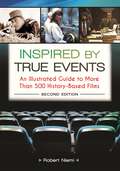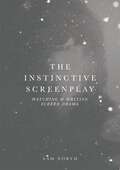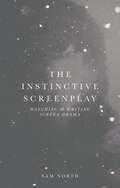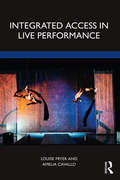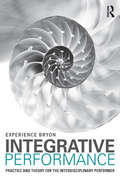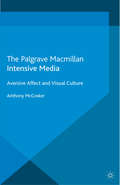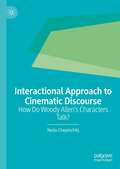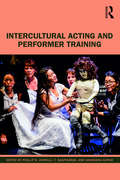- Table View
- List View
The Insiders' Guide to Factual Filmmaking
by Tony StarkThe Insiders’ Guide to Factual Filmmaking is an accessible and comprehensive ‘how to’ guide about the craft of making documentaries for TV, online or social media. Filmmaker Tony Stark distils a long career at the BBC and as an independent producer to explain the conceptual, visual, editorial and organisational skills needed to make impactful and stylish factual films. Interviews with top industry professionals in the UK and US - commissioners, executive producers, filmmakers, strand editors and media lawyers – add valuable insight and authority to this book. For more experienced filmmakers The Insiders’ Guide tells you how to get the green light for undercover investigations, how to tell film stories online and on social media, and how to budget a factual film. This is a key text for anyone who wants to succeed in the rapidly changing, competitive freelance markets in Britain and America. It provides expert guidance to students on filmmaking courses, journalists wanting to move from print to video and non-professionals with an interest in film-making. Whatever the final destination of your film – and whatever the budget - The Insiders’ Guide provides a vital roadmap. The book’s accompanying website is a ‘show-me’ resource for new directors: with 24 specially-shot film clips illustrating the key rules of filmic grammar and sequence shooting – together with downloadable versions of essential production forms.
Inspired by True Events: An Illustrated Guide to More Than 500 History-Based Films
by Robert J. NiemiAn up-to-date and indispensable guide for film history buffs of all kind, this book surveys more than 500 major films based on true stories and historical subject matter.When a film is described as "based on a true story" or "inspired by true events," exactly how "true" is it? Which "factual" elements of the story were distorted for dramatic purposes, and what was added or omitted? Inspired by True Events: An Illustrated Guide to More Than 500 History-Based Films, Second Edition concisely surveys a wide range of major films, docudramas, biopics, and documentaries based on real events, addressing subject areas including military history and war, political figures, sports, and art. This book provides an up-to-date and indispensable guide for all film history buffs, students and scholars of history, and fans of the cinema.
Inspired by True Events: An Illustrated Guide to More Than 500 History-Based Films
by Robert J. NiemiAn up-to-date and indispensable guide for film history buffs of all kind, this book surveys more than 500 major films based on true stories and historical subject matter.When a film is described as "based on a true story" or "inspired by true events," exactly how "true" is it? Which "factual" elements of the story were distorted for dramatic purposes, and what was added or omitted? Inspired by True Events: An Illustrated Guide to More Than 500 History-Based Films, Second Edition concisely surveys a wide range of major films, docudramas, biopics, and documentaries based on real events, addressing subject areas including military history and war, political figures, sports, and art. This book provides an up-to-date and indispensable guide for all film history buffs, students and scholars of history, and fans of the cinema.
Instafame: Graffiti and Street Art in the Instagram Era
by Lachlan MacDowallInstafame charts the impact of Instagram – one of the world's most popular social media platforms – on visual culture in the decade following its launch. MacDowall traces the intuitive connections between graffiti, street art and Instagram, arguing that social media's unending battle for a viewer's attention is closely aligned with the eye-catching ethos of unsanctioned public art.
Instant Digital Audio: VASST Instant Series
by Douglas Spotted EagleThe rapid drop in costs of digital audio recording and production tools has led to widespread adoption by "non-audio" people. Multimedia producers, including videographers and graphic designers producing for the Web and other media, need to learn the many details of producing digital audio. Hot topics include selecting and using recording hardware including microphones, headphones, and monitors; how to use postproduction-editing software; and how to deliver the finished audio in an array of media/formats.Instant Digital Audio presents digital audio principals and techniques for the non-audio specialist. Videographers and multimedia producers who are new to audio learn how to select the hardware and software that they need and how to use it. Straightforward explanations supplemented with ample screenshots and technical data address recording and production topics including microphones and relevant applications, best practices in recording audio, and how to feed audio into the computer for editing. Postproduction topics include setting up a studio, acquisition and editing techniques, filtering, and restoration.
Instant Digital Audio: VASST Instant Series (Instant Ser.)
by Douglas Spotted EagleThe rapid drop in costs of digital audio recording and production tools has led to widespread adoption by "non-audio" people. Multimedia producers, including videographers and graphic designers producing for the Web and other media, need to learn the many details of producing digital audio. Hot topics include selecting and using recording hardware including microphones, headphones, and monitors; how to use postproduction-editing software; and how to deliver the finished audio in an array of media/formats.Instant Digital Audio presents digital audio principals and techniques for the non-audio specialist. Videographers and multimedia producers who are new to audio learn how to select the hardware and software that they need and how to use it. Straightforward explanations supplemented with ample screenshots and technical data address recording and production topics including microphones and relevant applications, best practices in recording audio, and how to feed audio into the computer for editing. Postproduction topics include setting up a studio, acquisition and editing techniques, filtering, and restoration.
The Instinctive Screenplay: Watching and Writing Screen Drama
by Sam NorthWhat is it that makes humans engage with a dramatic narrative? Is it linked to our primitive selves, contained within our instinctive experience? This innovative text argues that understanding how and why our human instincts are brought into play as we watch screen drama is the key to writing it. Analysing four powerful instincts – willpower, logic, morality and emotion – Sam North explores how they determine our level of involvement in their drama, and how screenwriters can use them to develop their craft. Including a variety of both well-known and less famous examples, from The Shawshank Redemption to Samira Makhmalbaf’s The Apple, this book offers a fresh new approach to thinking about, discussing and writing screenplays.
The Instinctive Screenplay: Watching and Writing Screen Drama
by Sam NorthWhat is it that makes humans engage with a dramatic narrative? Is it linked to our primitive selves, contained within our instinctive experience?This innovative text argues that understanding how and why our human instincts are brought into play as we watch screen drama is the key to writing it. Analysing four powerful instincts – willpower, logic, morality and emotion – Sam North explores how they determine our level of involvement in their drama, and how screenwriters can use them to develop their craft. Including a variety of both well-known and less famous examples, from The Shawshank Redemption to Samira Makhmalbaf's The Apple, this book offers a fresh new approach to thinking about, discussing and writing screenplays.
Instruments of Embodiment: Costuming in Contemporary Dance (Routledge Advances in Theatre & Performance Studies)
by Eric MullisInstruments of Embodiment draws on fashion theory and the philosophy of embodiment to investigate costuming in contemporary dance. It weaves together philosophical theory and artistic practice by closely analyzing acclaimed works by contemporary choreographers, considering interviews with costume designers, and engaging in practice-as-research. Topics discussed include the historical evolution of contemporary dance costuming, Merce Cunningham’s innovative collaborations with Robert Rauschenberg, and costumes used in Ohad Naharin’s Virus (2001) and in a ground-breaking Butoh solo by Tatsumi Hijikata. The relationship between dance costuming and high fashion, wearable computing, and the role costume plays in dance reconstruction are also discussed and, along the way, an anarchist materialism is articulated which takes an egalitarian view of artistic collaboration and holds that experimental costume designs facilitate new forms of embodied experience and ways of seeing the body. This study will be of great interest to students and scholars working in performance philosophy, philosophy of embodiment, dance and performance studies, and fashion theory.
Instruments of Embodiment: Costuming in Contemporary Dance (Routledge Advances in Theatre & Performance Studies)
by Eric MullisInstruments of Embodiment draws on fashion theory and the philosophy of embodiment to investigate costuming in contemporary dance. It weaves together philosophical theory and artistic practice by closely analyzing acclaimed works by contemporary choreographers, considering interviews with costume designers, and engaging in practice-as-research. Topics discussed include the historical evolution of contemporary dance costuming, Merce Cunningham’s innovative collaborations with Robert Rauschenberg, and costumes used in Ohad Naharin’s Virus (2001) and in a ground-breaking Butoh solo by Tatsumi Hijikata. The relationship between dance costuming and high fashion, wearable computing, and the role costume plays in dance reconstruction are also discussed and, along the way, an anarchist materialism is articulated which takes an egalitarian view of artistic collaboration and holds that experimental costume designs facilitate new forms of embodied experience and ways of seeing the body. This study will be of great interest to students and scholars working in performance philosophy, philosophy of embodiment, dance and performance studies, and fashion theory.
Integrated Access in Live Performance
by Louise Fryer Amelia CavalloTwelve per cent of UK theatregoers have a disability. This compares with 18% of the UK’s adult population. Directors can help build audiences as diverse as the population at large by making their art accessible to all. Live performances are increasingly being made accessible to people with sensory impairments not only to satisfy equality laws and the requirements of funding bodies, but also in the interest of diversity and as a catalyst for creativity. But how do you ensure you don’t throw out the access baby with the artistic bathwater? This book draws on the results of the Integrated Access Inquiry: Is It Working? A qualitative study with 20 theatremakers from around the UK, it was commissioned by Extant Theatre – the UK’s leading company of blind and visually impaired people, and combines feedback from disabled audiences with advice from the creative teams who have experimented with integrating access. It discusses the challenges and opportunities of working with disabled actors and building in audience access even before rehearsals begin. It offers strategies, case studies and a step-by-step guide to help creative people integrate access into their live performance for the benefit of all.
Integrated Access in Live Performance
by Louise Fryer Amelia CavalloTwelve per cent of UK theatregoers have a disability. This compares with 18% of the UK’s adult population. Directors can help build audiences as diverse as the population at large by making their art accessible to all. Live performances are increasingly being made accessible to people with sensory impairments not only to satisfy equality laws and the requirements of funding bodies, but also in the interest of diversity and as a catalyst for creativity. But how do you ensure you don’t throw out the access baby with the artistic bathwater? This book draws on the results of the Integrated Access Inquiry: Is It Working? A qualitative study with 20 theatremakers from around the UK, it was commissioned by Extant Theatre – the UK’s leading company of blind and visually impaired people, and combines feedback from disabled audiences with advice from the creative teams who have experimented with integrating access. It discusses the challenges and opportunities of working with disabled actors and building in audience access even before rehearsals begin. It offers strategies, case studies and a step-by-step guide to help creative people integrate access into their live performance for the benefit of all.
Integrated Storytelling by Design: Concepts, Principles and Methods for New Narrative Dimensions
by Klaus Sommer PaulsenThis pioneering work equips you with the skills needed to create and design powerful stories and concepts for interactive, digital, multi-platform storytelling and experience design that will take audience engagement to the next level. Klaus Sommer Paulsen presents a bold new vision of what storytelling can become if it is reinvented as an audience-centric design method. His practices unlock new ways of combining story with experience for a variety of existing, new and upcoming platforms. Merging theory and practice, storytelling and design principles, this innovative toolkit instructs the next generation of creators on how to successfully balance narratives, design and digital innovation to develop strategies and concepts that both apply and transcend current technology. Packed with theory and exercises intended to unlock new narrative dimensions, Integrated Storytelling by Design is a must-read for creative professionals looking to shape the future of themed, branded and immersive experiences.
Integrated Storytelling by Design: Concepts, Principles and Methods for New Narrative Dimensions
by Klaus Sommer PaulsenThis pioneering work equips you with the skills needed to create and design powerful stories and concepts for interactive, digital, multi-platform storytelling and experience design that will take audience engagement to the next level. Klaus Sommer Paulsen presents a bold new vision of what storytelling can become if it is reinvented as an audience-centric design method. His practices unlock new ways of combining story with experience for a variety of existing, new and upcoming platforms. Merging theory and practice, storytelling and design principles, this innovative toolkit instructs the next generation of creators on how to successfully balance narratives, design and digital innovation to develop strategies and concepts that both apply and transcend current technology. Packed with theory and exercises intended to unlock new narrative dimensions, Integrated Storytelling by Design is a must-read for creative professionals looking to shape the future of themed, branded and immersive experiences.
Integrative Performance: Practice and Theory for the Interdisciplinary Performer
by Experience BryonIntegrative Performance serves a crucial need of 21st-century performers by providing a transdisciplinary approach to training. Its radical new take on performance practice is designed for a climate that increasingly requires fully rounded artists. The book critiques and interrogates key current practices and offers a proven alternative to the idea that rigorous and effective training must separate the disciplines into discrete categories of acting, singing, and dance. Experience Bryon’s Integrative Performance Practice is a way of working that will profoundly shift how performers engage with their training, conditioning and performance disciplines. It synthesizes the various elements of performance work in order to empower the performer as they practice across disciplines within any genre, style or aesthetic. Theory and practice are balanced throughout, using: Regular box-outs, introducing the work's theoretical underpinnings through quotes, case studies and critical interjections. A full program of exercises ranging from training of specific muscle groups, through working with text, to more subtle structures for integrative awareness and presence. This book is the result of over twenty years of practice and research working with interdisciplinary artists across the world to produce a training that fully prepares performers for the demands of contemporary performance and all its somatic, emotive and vocal possibilities.
Integrative Performance: Practice and Theory for the Interdisciplinary Performer
by Experience BryonIntegrative Performance serves a crucial need of 21st-century performers by providing a transdisciplinary approach to training. Its radical new take on performance practice is designed for a climate that increasingly requires fully rounded artists. The book critiques and interrogates key current practices and offers a proven alternative to the idea that rigorous and effective training must separate the disciplines into discrete categories of acting, singing, and dance. Experience Bryon’s Integrative Performance Practice is a way of working that will profoundly shift how performers engage with their training, conditioning and performance disciplines. It synthesizes the various elements of performance work in order to empower the performer as they practice across disciplines within any genre, style or aesthetic. Theory and practice are balanced throughout, using: Regular box-outs, introducing the work's theoretical underpinnings through quotes, case studies and critical interjections. A full program of exercises ranging from training of specific muscle groups, through working with text, to more subtle structures for integrative awareness and presence. This book is the result of over twenty years of practice and research working with interdisciplinary artists across the world to produce a training that fully prepares performers for the demands of contemporary performance and all its somatic, emotive and vocal possibilities.
Intensive Media: Aversive Affect and Visual Culture
by A. McCoskerThere is something unsettling, but also powerful, in the encounter with individual and collective experiences of human suffering. Intensive Media explores the discomfort and fascination initiated by instances of pain and suffering, their 'aversive affects', as they trouble but also vitalise contemporary media environments.
Interactional Approach to Cinematic Discourse: How Do Woody Allen’s Characters Talk?
by Neda ChepinchikjThis book analyses and describes a segment of Woody Allen’s cinematic discourse, focusing specifically on the performed (or diegetic) interactions between actors in various roles in some of his films. It is a case study of Woody Allen's cinematic discourse, encompassing the on-screen, performed interaction in the films at the level of the story-world. The analysis focuses on speech (film dialogues), in both its verbal and prosodic forms, as well as non-verbal types of interaction including gaze and gesture, taking a social interactional approach and using multimodal conversation analysis as a theoretical framework and analytical tool. The 'texts' under study are segments from five films by Woody Allen, and the analysed interactions take place between male and female interactants, which allows further examination of on-screen interactions via a gender lens. The book aims to bridge the gap between the disciplines of applied linguistics and cinema studies and offer linguistic insights into performed interactions from a multimodal point of view. It will be equally relevant to linguists who are interested in how verbal and non-verbal language is used in cinematic discourse, as well as to film workers, especially actors, directors and screenwriters.
Interactive Narratives and Transmedia Storytelling: Creating Immersive Stories Across New Media Platforms
by Kelly McErleanInteractive Narratives and Transmedia Storytelling provides media students and industry professionals with strategies for creating innovative new media projects across a variety of platforms. Synthesizing ideas from a range of theorists and practitioners across visual, audio, and interactive media, Kelly McErlean offers a practical reference guide and toolkit to best practices, techniques, key historical and theoretical concepts, and terminology that media storytellers and creatives need to create compelling interactive and transmedia narratives. McErlean takes a broad lens, exploring traditional narrative, virtual reality and augmented reality, audience interpretation, sound design, montage, the business of transmedia storytelling, and much more. Written for both experienced media practitioners and those looking for a reference to help bolster their creative toolkit or learn how to better craft multiplatform stories, Interactive Narratives and Transmedia Storytelling serves as a guide to navigating this evolving world.
Interactive Narratives and Transmedia Storytelling: Creating Immersive Stories Across New Media Platforms
by Kelly McErleanInteractive Narratives and Transmedia Storytelling provides media students and industry professionals with strategies for creating innovative new media projects across a variety of platforms. Synthesizing ideas from a range of theorists and practitioners across visual, audio, and interactive media, Kelly McErlean offers a practical reference guide and toolkit to best practices, techniques, key historical and theoretical concepts, and terminology that media storytellers and creatives need to create compelling interactive and transmedia narratives. McErlean takes a broad lens, exploring traditional narrative, virtual reality and augmented reality, audience interpretation, sound design, montage, the business of transmedia storytelling, and much more. Written for both experienced media practitioners and those looking for a reference to help bolster their creative toolkit or learn how to better craft multiplatform stories, Interactive Narratives and Transmedia Storytelling serves as a guide to navigating this evolving world.
Interactive Storytelling for the Screen (PERFORM)
by Sylke Rene MeyerAn invaluable collection of essays and interviews exploring the business of interactive storytelling, this highly accessible guide offers invaluable insight into an ever-evolving field that is utilizing new spatial and interactive narrative forms to tell stories. This includes new media filmmaking and content creation, a huge variety of analog story world design, eXtended realities, game design, and virtual reality (VR) design. The book contains essays written by and interviews with working game designers, producers, 360-degree filmmakers, immersive theatre creators, and media professors, exploring the business side of interactive storytelling – where art meets business. Contributors to this book share their perspectives on how to break into the field; how to develop, nurture, and navigate business relationships; expectations in terms of business etiquette; strategies for contending with the emotional highs and lows of interactive storytelling; how to do creative work under pressure; the realities of working with partners in the field of new media narrative design; prepping for prototyping; writing analog and digital. This is an ideal resource for students of filmmaking, screenwriting, media studies, RTVF, game design, VR and AR design, theater, and journalism who are interested in navigating a career pathway in the exciting field of interactive storytelling.
Interactive Storytelling for the Screen (PERFORM)
by Sylke Rene MeyerAn invaluable collection of essays and interviews exploring the business of interactive storytelling, this highly accessible guide offers invaluable insight into an ever-evolving field that is utilizing new spatial and interactive narrative forms to tell stories. This includes new media filmmaking and content creation, a huge variety of analog story world design, eXtended realities, game design, and virtual reality (VR) design. The book contains essays written by and interviews with working game designers, producers, 360-degree filmmakers, immersive theatre creators, and media professors, exploring the business side of interactive storytelling – where art meets business. Contributors to this book share their perspectives on how to break into the field; how to develop, nurture, and navigate business relationships; expectations in terms of business etiquette; strategies for contending with the emotional highs and lows of interactive storytelling; how to do creative work under pressure; the realities of working with partners in the field of new media narrative design; prepping for prototyping; writing analog and digital. This is an ideal resource for students of filmmaking, screenwriting, media studies, RTVF, game design, VR and AR design, theater, and journalism who are interested in navigating a career pathway in the exciting field of interactive storytelling.
Interchangeable Parts: Acting, Industry, and Technology in US Theater (Theater: Theory/Text/Performance)
by Victor HoltcampWhile Hollywood has long been called “The Dream Factory,” and theatrical entertainment more broadly has been called “The Industry,” the significance of these names has rarely been explored. There are in fact striking overlaps between industrial rhetoric and practice and the development of theatrical and cinematic techniques for rehearsal and performance. Interchangeable Parts examines the history of acting pedagogy and performance practice in the United States, and their debts to industrial organization and philosophy. Ranging from the late nineteenth century through the end of the twentieth, the book recontextualizes the history of theatrical technique in light of the embrace of industrialization in US culture and society. Victor Holtcamp explores the invocations of scientific and industrial rhetoric and philosophy in the founding of the first schools of acting, and echoes of that rhetoric in playwriting, production, and the cinema, as Hollywood in particular embraced this industrially infected model of acting. In their divergent approaches to performance, the major US acting teachers (Lee Strasberg, Stella Adler, and Sanford Meisner) demonstrated strong rhetorical affinities for the language of industry, illustrating the pervasive presence of these industrial roots. The book narrates the story of how actors learned to learn to act, and what that process, for both stage and screen, owed to the interchangeable parts and mass production revolutions.
Intercultural Acting and Performer Training
by Zarrilli Phillip T Sasitharan Anuradha KapurIntercultural Acting and Performer Training is the first collection of essays from a diverse, international group of authors and practitioners focusing on intercultural acting and voice practices worldwide. This unique book invites performers and teachers of acting and performance to explore, describe, and interrogate the complexities of intercultural acting and actor/performer training taking place in our twenty-first century, globalized world. As global contexts become multi-, inter- and intra-cultural, assumptions about what acting "is" and what actor/performer training should be continue to be shaped by conventional modes, models, techniques and structures. This book examines how our understanding of interculturalism changes when we shift our focus from the obvious and highly visible aspects of production to the micro-level of training grounds, studios, and rehearsal rooms, where new forms of hybrid performance are emerging. Ideal for students, scholars and practitioners, Intercultural Acting and Performer Training offers a series of accessible and highly readable essays which reflect on acting and training processes through the lens offered by "new" forms of intercultural thought and practice.
Intercultural Acting and Performer Training
by Zarrilli Phillip T Sasitharan Anuradha KapurIntercultural Acting and Performer Training is the first collection of essays from a diverse, international group of authors and practitioners focusing on intercultural acting and voice practices worldwide. This unique book invites performers and teachers of acting and performance to explore, describe, and interrogate the complexities of intercultural acting and actor/performer training taking place in our twenty-first century, globalized world. As global contexts become multi-, inter- and intra-cultural, assumptions about what acting "is" and what actor/performer training should be continue to be shaped by conventional modes, models, techniques and structures. This book examines how our understanding of interculturalism changes when we shift our focus from the obvious and highly visible aspects of production to the micro-level of training grounds, studios, and rehearsal rooms, where new forms of hybrid performance are emerging. Ideal for students, scholars and practitioners, Intercultural Acting and Performer Training offers a series of accessible and highly readable essays which reflect on acting and training processes through the lens offered by "new" forms of intercultural thought and practice.


